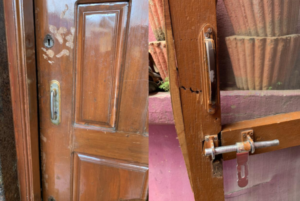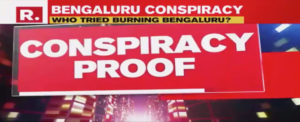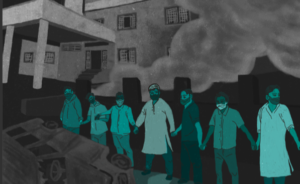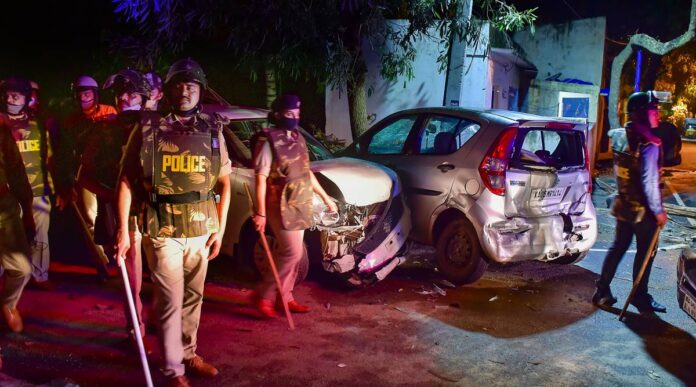“Several sections of the media have misportrayed the incident in a communal light by spinning conspiracy theories and targeting the Muslim community.”
On August 11th an offensive Facebook post by P. Naveen Kumar triggered a chain of events that would result in violence at Kadugondanahalli (K.G. Halli) and Devarajeevanahalli (D.J. Halli) police stations and in other places including Kaval Byrasandra in Bangalore.
A fact-finding report from civil society groups called “Communalising Violence in D.J Halli” shows that the police did not follow due process to identify those involved in the Bangalore violence on August 11th, 2020. The report also states that the police arbitrarily arrested, isolated young Muslim men in the area. The report also counters false narratives that emerged since the incident, that communalize the incident and disproportionately attack vulnerable people.
The Incident
On August 11th at 5:46, Naveen Kumar (nephew of a Congress MLA, Akhanda Shrinivas Murthy) posted an incendiary image of the prophet. Shortly after Kumar’s post was published, a handful of people approached police at K.G. Halli and D.J Halli to register for an FIR against Naveen for his Facebook post, which could be legally considered hate speech. The report explores two versions on this: the people’s narrative following eye witnesses and community leaders, as well as the police narrative, based on 53 FIRs (21 were filed by the police).
By all accounts, the mob largely consisted of youths between the ages of 18-25. Many were not from the local area; as P.M Muzammil notes, community leaders did not recognise the people in the crowd, and at D.J Halli none of them could run into the mohallas when the firing or lathi charge began, or tear gas released. At both stations the crowds gathered separately from those who had filed the complaints. They were also initially peaceful and less in number, but swelled over the hours to around 2000, especially in areas like Kaval Byrasandra, where Naveen lived.
The response of State Forces
- Police Inaction
A major reason why the violence escalated was because of police inaction on two fronts. Firstly, there was a delay in the initial filing of the complaint, despite promises made to those filing complaints that Naveen would be arrested immediately. The crowd gathered in greater numbers as time passed, and became agitated as vehicles entered and exited the compounds without attempts at arrest. The Social Democratic Party of India (SDPI) also suggested that the police delayed filing the FIR to protect Naveen, an MLA’s nephew. Members in the crowd also felt the same, and that other MLAs who were trying to pacify them were also protecting Naveen.
Secondly, the police did not respond as soon as the crowd started gathering, which allowed them to vent and grow increasingly angrier. Instead, the burden was placed on community leaders who had come to file the complaints, or after hearing of the violence. The police already had a tense relationship with the local community as, in the past, there had been two custodial deaths and one judicial death. The police also used to torture the locals, making it difficult to trust them. At D.J Halli, eyewitnesses described them as “confused and lacking in leadership”. They did not intervene until the Commissioner arrived almost two and a half hours after the crowd had become agitated, and they immediately lathi-charged, released tear gas, and fired at the crowd. Similarly, at K.J Halli the police waited for too long before taking action, before using violent measures to control the crowd.
2. Arbitrary Arrests of Muslims Youth- Section 144 & UAPA
“Rashida narrated that they came out of their house at 9.30 PM on August 11 when they heard noises, they saw a lot of people running. They then learnt of the Facebook post. She said that there was no electricity between 12.00 am and 1.00 am and they heard firing in the area. “The policemen were spread out in groups of five in the neighbourhood. About 140 youths were picked up that night,” she said.
On August 12th, a prohibitory order of Section 144 was established and extended every day till 6 am on August 16th. This prohibited people from carrying arms, gathering in groups of three or more, and even singing, playing music, displaying images, signals, posters. Anyone breaking these could be arrested for “rioting”.
Through the imposition of Section 144, the police were able to create a toxic and anxiety-inducing environment. They verbally and physically harassed people for stepping out of the house. They cut off electricity from the people in their jurisdiction one day. When people of the Secular Advocates Forum brought food as it would have been difficult for people to purchase food grains, the police barred them, saying, “We want to punish them and you want to feed them?”
This, along with the UAPA, proved to be a way for the police to “punish” people who lived in those areas, and vent their frustrations on vulnerable young, Muslim boys. The report explains that the UAPA is a draconian law which turns all basic principles of criminal jurisprudence on their head and don’t allow the possibility of a fair trial.
According to all accounts, innocent bystanders were arrested. Many of them were minors, and picked up by plainclothes officers. Other than in 1-2 cases, most of the arrest occurred between 1-4:30 am, creating a tense atmosphere. This was often without the family’s knowledge. In many cases, the families did not know about their whereabouts even after they were informed of the arrest. The police also did not explain why they were arresting these boys. One 16 year old, a car mechanic, had to give Rs. 1,60,000 to the police to release him.

At Zafrulla Layout, which the police raided on the night of August 11, the police barged into people’s homes and broke their windows, doors, etc. The police were very clearly targeting muslims, as they let a family go back into their homes when they realised they were Christian. Most of the men picked up were working class and two were studying. One woman who had been going to the Police Station to find out about her family recounted that the police beat them up and sent them away multiple times.
“They just put them all in a bus and took them away. We hear stories about jails being overcrowded. During times of the Covid-19 illness we are afraid for them. They went away healthy, we don’t know in what state they will return. There will be no one to take care of them in case they fall ill.”
Narratives Around the Incident
Since the incident, various narratives were being created, especially to politicise the issue. Three fact finding teams were announced: by Congress, BJP, and “Citizens for Democracy” group. The third included many RSS members. Through close reading, the report shows that it lacks objectivity, and is biased towards a conspiracy theory created by the media and state government: that the violence was communal and pre-planned. The report deconstructs these ideas and shows how the media and government made it mainstream.
1. Media Fuelled Islamophobia
Barring a few media outlets, coverage of events of August 11th was biased. English and Kannada news outlets fuelled Islamophobic suspicions through unsubstantiated speculations.
Viewers are gaslighted into forming an opinion, where they introduced suspicions into viewers’ mind by adding quotations to factual elements. Most news channels would only add these when speaking of the derogatory nature of the post, making the violence seem as if they came out of nowhere.
There seems to have been a conscious effort by mainstream media to make it seem as if Naveen’s post was a response; they fabricated a reply to an image shared by Adyar Basheer which allegedly targeted Hindu Gods and Modi. However, media outlets that fact-checked the post were not able to find evidence of this, but this has not been as sensationalised or visible as the former claim. Even if Naveen did not mean to incite violence, they along with the police failed in assessing his motivations, instead gave him a free pass.

Besides this, news media such as Zee News, The Free Press Journal picked up narratives from twitter posed by the BJP It Cell and posited them as facts. They called the incident pre-planned, created links to “Islamic” terror, and implied connections between the Delhi Riots and Bengaluru Riots. Finally, the groups presented were alienated by the state, with Revenue Minister R. Ashoka deeming protestors “traitors”.
Kannada Media also followed similar patterns, but as it happened in the State’s capital, media coverage was extensive. Though narratives used national and international elements to link the crowd to the aforementioned forces, they emphasised local details to criminalise and create long-term repercussions for residents of D.J Halli and K.G Halli.
2. Political Conspiracies
Political ambitions fuelled conspiracy theories. Media outlets conspired that the violence was a result of local rivalry between corporators and MLAs, and infighting within the Congress. Early investigations, sensationalised by the media, also suggested a pre-planned conspiracy by the SDPI.
3. Role of Social Media
Even though they moderate content, Facebook and Instagram did not take action against Naveen’s post, which can be considered as hate speech. Nevertheless, Facebook regularly takes down posts that are not in support of the current political regime, and anti-Hindutva personalities being taken off the platforms.
The images analysed by the group show that several popular Muslim social media handles urged people to stay indoors and not to add to the existing tensions. However, these platforms lacked regulation, and misinformation and selective facts rapidly spread. This combined with people’s existing basis, increased hate towards Muslims.
Besides this, after the incident, the BJP IT cell was able to regularly create conspiracy theories that were not being fact-checked or self-regulated by the platforms.
Validity of Communal Violence
There isn’t evidence suggesting that mob violence was communal in nature. It wasn’t pre-planned or meant to target Hindus. While some members did attack the private property of some Hindus, it seems to have been based on personal vendettas. Notwithstanding, Firdos Pasha registered the first FIR against Naveen, and at 9:00 his vehicle was also torched.

Many Muslims also protected Hindu temples by making human chains around them. Munigowda, who lived near Naveen and whose home was burnt when their family was away, said that Muslim locals slept near the house to protect it. Other residents such as Arun Gowda echoed similar stories of solidarity. Munigowda also mentioned that CCTV footage caught some people distributing money to rioters, and alleges that they might have torched the place to frame Muslim locals.
However, according to all eyewitness accounts, there was also no visible leadership controlling the crowd. The locals identified were unemployed youth who felt alienated by the increasing institutionalised Islamophobia in the country. In fact, many Muslim community leaders spent 3-4 hours trying to ease the crowd, while the police did not intervene until late. Some accounts also state that the police instigated people, trashing members of Swaraj India with lathis after they left, around 2:00 am.
They recall that one person in the mob was very angry and was saying, “Yejmaan how much more can we take? Babri masjid, CAA, how much more?”
They report that though the area around D.J was largely dominated by Muslims, people there lived harmoniously. However, many felt that the RSS and BJP have been using discontent amongst Muslim youth for personal gains, and have been providing assistance only to Hindus in the area. While chronic neglect by the state has led to deprivation for all community members, the RSS has increased presence in Dalit pockets in these areas to divide the area along communal lines, and to appropriate Dalit voices into a Hindutva fold. Therefore, even though frustrated Muslim youth took part in the violence because of continued attacks on their religion, they weren’t inciting communal tensions.
Key Suggestions:
- Widen the scope of investigation against Naveen’s post
- Investigate intelligence failure in predicting the violence as well the police’s failure in to communicate with the mob.
- Take forward a socio-economic survey in the two police stations
- Implement the Justice Rajinder Sachar Committee Report and 15 Point Programme for the Welfare of Minorities.
- Steps must be taken against the spreading of Islamophobia through mass media as well as in person.
- Media should be self-regulating and not sensationalise the news.
- UAPA charges must be dropped, families of the arrested must be informed.



